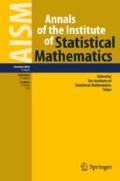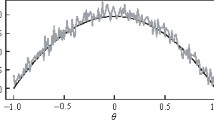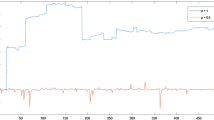Appendix
Proof of Theorem 1
Let the filtration \(\{ \mathcal{F}\}_{n\ge 0}\) be given by (17). We will show that the characteristic function of vector \(\xi =(\xi _1,\xi _2)\) with the coordinates defined in (6) has the form
$$\begin{aligned} \varphi _{\xi }(u)=Ee^{i(u,\xi )}=Ee^{i(u_1 \xi _1+u_2 \xi _2)}=e^{-\frac{u_1^2}{2}}e^{-\frac{u_2^2}{2}}, \end{aligned}$$
\(u=(u_1,u_2),\ \ -\infty<u_j<\infty , \ j=1,2.\) Taking into account (11), we introduce two sequences
$$\begin{aligned} \xi _1(N)= & {} \frac{1}{\sqrt{h}}\sum _{k=1}^N \chi _{(k\le \tau _1(h))}\beta _{1,k}x_{k-1}^+\varepsilon _k, \\ \xi _2(N)= & {} \frac{1}{\sqrt{h}}\sum _{j=1}^N \chi _{(j\le \tau _2(h))}\beta _{2,j}x_{j-1}^+\varepsilon _j, \ \ N\ge 1. \end{aligned}$$
Consider the characteristic function of the vector \(\xi (N)=(\xi _1(N),\xi _2(N))\):
$$\begin{aligned} \varphi _{\xi (N)}(u)=Ee^{i(u,\xi (N))}=E\exp \left( \sum _{k=1}^N \frac{i}{\sqrt{h}}y_{k-1}\varepsilon _k \right) \end{aligned}$$
where
$$\begin{aligned} y_{k-1}=\chi _{(k\le \tau _1(h))}\beta _{1,k}u_1x_{k-1}^+\ +\ \chi _{(k\le \tau _2(h))}\beta _{2,k}u_2x_{k-1}^-. \end{aligned}$$
Since
$$\begin{aligned} \lim _{N\rightarrow \infty }\xi _1(N)=\xi _1, \ \ \ \lim _{N\rightarrow \infty }\xi _2(N)=\xi _2, \end{aligned}$$
we have
$$\begin{aligned} \varphi _{\xi }(u)=\lim _{N\rightarrow \infty }\varphi _{\xi (N)}(u). \end{aligned}$$
Now, we represent \(\varphi _{\xi (N)}(u)\) as
$$\begin{aligned}&\varphi _{\xi (N)}(u)=E\exp \left( \left( \sum _{k=1}^N \frac{i}{\sqrt{h}}y_{k-1}\varepsilon _k +\frac{1}{2h}y_{k-1}^2\right) - \sum _{k=1}^N \frac{1}{2h}y_{k-1}^2\right) \nonumber \\&\quad =\exp \left( -\frac{u_1^2}{2}-\frac{u_2^2}{2}\right) E\exp \left( \sum _{k=1}^N \frac{i}{\sqrt{h}}y_{k-1}\varepsilon _k +\frac{1}{2h}y_{k-1}^2\right) \ +\ R_N, \end{aligned}$$
(52)
where
$$\begin{aligned} R_N= & {} E\left[ \exp (\eta _N)\cdot S_N\right] , \\ \eta _N= & {} \sum _{k=1}^N \left( \frac{i}{\sqrt{h}}y_{k-1}\varepsilon _k +\frac{1}{2h}y_{k-1}^2\right) , \\ S_N= & {} E\exp \left( \sum _{k=1}^N \frac{1}{2h}y_{k-1}^2\right) -\exp \left( -\frac{u_1^2}{2}-\frac{u_2^2}{2}\right) . \end{aligned}$$
Taking repeatedly conditional expectation yields
$$\begin{aligned}&E e^{\eta (N)}=E \left( E \left( e^{\eta (N)}|\mathcal{F}_{N-1}\right) \right) \nonumber \\&\quad =E\exp \left( \sum _{k=1}^{N-1} \frac{i}{\sqrt{h}}y_{k-1}\varepsilon _k +\sum _{k=1}^{N}\frac{1}{2h}y_{k-1}^2\right) E\exp \left( \frac{i}{\sqrt{h}}y_{N-1}\varepsilon _N|\mathcal{F}_{N-1}\right) \nonumber \\&\quad =E\left[ \exp \left( \sum _{k=1}^{N-1} \left( \frac{i}{\sqrt{h}}y_{k-1}\varepsilon _k +\frac{1}{2h}y_{k-1}^2\right) \right) \right] = E e^{\eta (N-1)}=\cdots =1. \end{aligned}$$
(53)
Further, we note that
$$\begin{aligned}&\sum _{k=1}^{N}\frac{1}{2h}y_{k-1}^2 \le \frac{1}{2}\left( u_1^2+u_2^2\right) , \\&\lim _{N\rightarrow \infty }\sum _{k=1}^{N}\frac{1}{2h}y_{k-1}^2 =\frac{1}{2}\left( u_1^2+u_2^2\right) . \end{aligned}$$
Using the estimate
$$\begin{aligned} E e^{\eta (N)}\le \exp \left( \frac{1}{2}\left( u_1^2+u_2^2\right) \right) \end{aligned}$$
and applying the theorem of dominated convergence, one gets
$$\begin{aligned} \lim _{N\rightarrow \infty }R_N=0. \end{aligned}$$
Substituting (53) in (52) and limiting \(N\rightarrow \infty \), we arrive at the desired result. Thus, Theorem 2.1 is proved. \(\square \)
Proof of Lemma 2
Noting that
$$\begin{aligned} |x_k|\ \le \ \lambda |x_{k-1}|+|\varepsilon _k|, \ \ k\ge 1, \end{aligned}$$
and applying this inequality repeatedly, one gets
$$\begin{aligned} |x_k|\ \le \ \lambda ^n|x_{0}|+\sum _{j=1}^n \lambda ^{n-j}|\varepsilon _j. \end{aligned}$$
This implies the following estimate \(N<n\)
$$\begin{aligned}&\frac{|x_k|}{\sqrt{n}}\ \le \ \frac{\lambda ^n}{\sqrt{n}}|x_{0}|+\frac{1}{\sqrt{n}}\sum _{j=0}^N \lambda ^{n-j}|\varepsilon _j|+\frac{1}{\sqrt{n}}\sum _{j=N+1}^n \lambda ^{n-j}|\varepsilon _j| \\&\quad \le \frac{\lambda ^n}{\sqrt{n}}|x_{0}|+\frac{1}{\sqrt{n}}\sum _{j=0}^N \lambda ^{n-j}|\varepsilon _j|+\frac{1}{1-\lambda }\sup \frac{|\varepsilon _j|}{\sqrt{j}}. \end{aligned}$$
Limiting \(n\rightarrow \infty ,\) then \(N\rightarrow \infty \) and thanks the strong law of large numbers one comes to (31). \(\square \)
Proof of Lemma 5
For each \(\theta \in \varTheta _{\lambda }\), the process \(M_n'\) in decomposition (25) is a square integrable martingale subjected to the strong law of large numbers:
$$\begin{aligned} \lim _{n\rightarrow \infty }\frac{M_n'}{n}\rightarrow 0\ \ (P_{\theta }-\ \text{ a.s.}). \end{aligned}$$
Moreover, this convergence is uniform in \(\theta \in \varTheta _{\lambda }\), i.e., for any \(\mu >0\)
$$\begin{aligned} \sup _{\theta \in \varTheta _{\lambda }}P_{\theta }\left\{ \sup _{n\ge m}\frac{|M_n'|}{n}\ge \mu \right\} \rightarrow \ 0\ \ \text{ a.s. }\ m\rightarrow \infty . \end{aligned}$$
(54)
This can be checked by making use of the inequality (see, e.g., Shiryaev (1996))
$$\begin{aligned}&\mu ^2 P_{\theta }\left\{ \sup _{n\ge m}\frac{|M_n'|}{n}\ge \mu \right\} = \mu ^2 \lim _{l\rightarrow \infty }P_{\theta }\left\{ \max _{m\le n\le l}\frac{(M_n')^2}{n^2}\ge \mu ^2 \right\} \nonumber \\&\quad \le \frac{1}{m^2}E_{\theta }(M_n')^2\ +\ \sum _{n\ge m} E_{\theta }\left( (M_n')^2-(M_{n-1}')^2 \right) \nonumber \\&\quad =\ \sum _{n\ge m+1} \left( \frac{1}{(n-1)^2}-\frac{1}{n^2}\right) E_{\theta }(M_{n-1})^2. \end{aligned}$$
(55)
From the definition of \(M_n'\), it follows that
$$\begin{aligned} E_{\theta }(M_j')^2=\sum _{i=1}^j E_{\theta }(\varDelta M_j')^2\le j\cdot E\varepsilon _1^4. \end{aligned}$$
Using the estimate in (54), one gets
$$\begin{aligned} \sup _{\theta \in \varTheta _{\lambda }}P_{\theta }\left\{ \sup _{n\ge m}\frac{|M_n'|}{n}\ge \mu \right\} \ \le \ \frac{2E \varepsilon _1^4}{\mu ^2m}. \end{aligned}$$
(56)
This inequality provides the rate of convergence in (54). Now, we are ready to show (39). It remains to notice that the numerator of (38), thanks to Lemma 2 and the strong law of large numbers, tends to zero uniformly in \(\theta \in \varTheta _{\lambda }\) and the denominator of (38), in view of (54), is bounded away from zero below by some positive constant uniformly in \(\theta \in \varTheta _{\lambda }\). Thus, we arrive at (39). Lemma 5 is proved. \(\square \)
Proof of Proposition 2
As in Lai and Siegmund (1983), we need the following martingale central limit theorem from Freedman (1983), pages 90–92.
Lemma 6
Let \(0<\delta <1\) and \(r>0.\) Assume that \((u_n,\mathcal{F}_n)_{n\ge 0}\) is a martingale difference sequence satisfying
$$\begin{aligned} |u_n|\le \delta \ \ \text{ for } \text{ all }\ n \end{aligned}$$
and
$$\begin{aligned} \sum E\left( u_n^2|\mathcal{F}_{n-1}\right) >r \ \ \text{ a.s. } \end{aligned}$$
Let
$$\begin{aligned} \tau (h)=\inf \left\{ n\ge 1: \ \sum _{k=1}^n E\left( u_k^2|\mathcal{F}_{k-1}\right) \ge r \right\} . \end{aligned}$$
There exists a function \(\rho :\ (0,\infty ) \rightarrow \left[ 0,2\right] \), not depending on the distribution of martingale difference sequence, such that \(\lim \rho (x)=0\) as \(x\rightarrow 0\) and
$$\begin{aligned} \sup \limits _{x\in R} \left| P\left( \sum _{k=1}^{\tau } u_k\le x\right) -\varPhi \left( \frac{x}{\sqrt{\rho }}\right) \right| \le \rho \left( \frac{\delta }{\sqrt{\rho }}\right) . \end{aligned}$$
Proof of Proposition 2.
For each \(0<\delta <1\), we define truncated versions for both processes \(\{x_k^+\}_{k\ge 0}\) and \(\{x_k^-\}_{k\ge 0}\):
$$\begin{aligned}&{\tilde{x}}_k^+ = \left\{ \begin{array}{lll} x_k^+ &{} \text{ if } &{} (x_k^+)^2\le \delta ^2 h,\\ \delta \sqrt{h}&{} \text{ if } &{} (x_k^+)^2>\delta ^2 h; \end{array} \right. \\&{\tilde{x}}_k^- = \left\{ \begin{array}{lll} x_k^- &{} \text{ if } &{} (x_k^-)^2\le \delta ^2 h,\\ -\delta \sqrt{h}&{} \text{ if } &{} (x_k^-)^2>\delta ^2 h. \end{array} \right. \end{aligned}$$
Then, we introduce the counterparts of stopping times (16) as
$$\begin{aligned}&T_1(h)=\inf \left\{ n\ge 1: \sum _{k=1}^n \left( {\tilde{x}}^+_{k-1} \right) ^2\ge h \right\} , \nonumber \\&T_2(h)=\inf \left\{ n\ge 1: \sum _{k=1} ^n\left( {\tilde{x}}^-_{k-1} \right) ^2\ge h \right\} , \nonumber \\&T(h)=T_1(h)\vee T_2(h). \end{aligned}$$
(57)
Let \({\tilde{\alpha }}_{1,T_1}\) and \({\tilde{\alpha }}_{2,T_2}\) be correction factors compensating the overshots in (57) computed from the equations
$$\begin{aligned}&\sum _{k=1}^{T_1(h) -1} \left( x_{k-1}^+ \right) ^2+{\tilde{\alpha }}_{1,T_1(h)}\left( x_{T_1(h)-1}^+ \right) ^2=h, \\&\sum _{k=1}^{T_2(h) -1} \left( x_{k-1}^- \right) ^2+{\tilde{\alpha }}_{2,T_2(h)}\left( x_{T_2(h)-1}^- \right) ^2=h. \end{aligned}$$
Denote
$$\begin{aligned} {\tilde{y}}_{k-1}={\tilde{\beta }}_{1,k}u_1{\tilde{x}}_{k-1}^+\ +\ {\tilde{\beta }}_{2,k}u_2{\tilde{x}}_{k-1}^-, \ \ 1\le k \le \tau (h), \end{aligned}$$
where
$$\begin{aligned} {\tilde{\beta }}_{i,k}=\left\{ \begin{array}{lll} 1 &{} \text{ if } &{} k<T_i(h),\\ \sqrt{{\tilde{\alpha }}_{i,T_i}}&{} \text{ if } &{} k=T_i(h), \\ 0 &{} \text{ if } &{} k>T_i(h); \ \ i=1,2, \end{array} \right. \end{aligned}$$
and
$$\begin{aligned} {\tilde{\varepsilon }}_k=\varepsilon _k\chi _{(|\varepsilon _k|\le 1/\sqrt{\delta })}, \ \ \tilde{{\tilde{\varepsilon }}}_k=\varepsilon _k-{\tilde{\varepsilon }}_k. \end{aligned}$$
Then, under \(P_{\theta }\)\(\left\{ \frac{1}{\sqrt{h}}{\tilde{y}}_{k-1}\left( {\tilde{\varepsilon }}_k- E {\tilde{\varepsilon }}_k\right) ,\ \mathcal{F}_k\right\} _{k\ge 0}\) is a martingale difference such that
$$\begin{aligned}&\left| \frac{1}{\sqrt{h}}{\tilde{y}}_{k-1}\left( {\tilde{\varepsilon }}_k- E {\tilde{\varepsilon }}_k\right) \right| \\&\quad =\left| \frac{1}{\sqrt{h}}\left( {\tilde{\beta }}_{1,k}u_1{\tilde{x}}_{k-1}^+\ +\ {\tilde{\beta }}_{2,k}u_2{\tilde{x}}_{k-1}^-\right) \left( {\tilde{\varepsilon }}_k- E {\tilde{\varepsilon }}_k\right) \right| \\&\quad \le \frac{1}{\sqrt{h}}2\delta \sqrt{h}\frac{2}{\sqrt{\delta }}=4\sqrt{\delta }. \end{aligned}$$
By Lemma 6
$$\begin{aligned} \left| P_{\theta }\left( \frac{1}{\sqrt{h}}\sum _{k=1}^{T(h)} {\tilde{y}}_{k-1}\left( {\tilde{\varepsilon }}_k- E {\tilde{\varepsilon }}_k\right) \le t\right) -\varPhi \left( \frac{t}{\sqrt{v_{\theta }(\delta )}}\right) \right| \le \rho \left( 4\frac{\delta }{\sqrt{v_{\theta }(\delta )}}\right) , \end{aligned}$$
(58)
where \(v_{\theta }(\delta )=\text{ Var}_{\theta }{\tilde{\varepsilon }}_1\rightarrow 1\) uniformly in \(\varTheta \) as \(\delta \rightarrow 0.\) We need the following sets
$$\begin{aligned} \varOmega _{1,h}= & {} \left\{ x_k^+={\tilde{x}}_k^+ \ \text{ for } \text{ all } \ k<\tau _1(h)\right\} , \\ \varOmega _{2,h}= & {} \left\{ x_k^-={\tilde{x}}_k^- \ \text{ for } \text{ all } \ k<\tau _2(h)\right\} , \\ \varOmega _{h}= & {} \varOmega _{1,h}\bigcap \varOmega _{2,h}. \end{aligned}$$
We will show that
$$\begin{aligned} \lim \limits _{h\rightarrow \infty }\sup \limits _{\theta \in \varTheta }P_{\theta }\left( \varOmega _{h}^c\right) =0. \end{aligned}$$
It suffices to check that
$$\begin{aligned} \lim \limits _{h\rightarrow \infty }\sup \limits _{\theta \in \varTheta }P_{\theta }\left( \varOmega _{i,h}^c\right) =0, \ \ i=1,2. \end{aligned}$$
(59)
For all \(\theta \) and \(h>0\), one has the inequality
$$\begin{aligned}&P_{\theta }\left( \varOmega _{i,h}^c\right) = P_{\theta }\left\{ x_k^+\ne {\tilde{x}}_k^+ \ \text{ for } \text{ some } \ k<\tau _1(h)\right\} \\&\quad \le \sum _{k=1}^m P_{\theta }\left\{ \left( x_{k-1}^+\right) ^2>\delta ^2 h\right\} \ + \ P_{\theta }\left\{ \tau _1(h), \ x_k^+\ne {\tilde{x}}_k^+ \ \text{ for } \text{ some } \ m\le k<\tau _1(h)\right\} \\&\quad \le \sum _{k=1}^m P_{\theta }\left\{ \left( x_{k-1}^+\right) ^2>\delta ^2 h\right\} \ + \ P_{\theta }\left\{ \left( x_n^+\right) ^2\ge \delta ^2\sum _{k=1}^n \left( x_{k-1}^+\right) ^2 \ \text{ for } \text{ some } \ n\ge m\right\} . \end{aligned}$$
From here, it follows
$$\begin{aligned}&\sup \limits _{\theta \in \varTheta }P_{\theta }\left( \varOmega _{i,h}^c\right) \ \le \sum _{k=1}^m \sup \limits _{\theta \in \varTheta }P_{\theta }\left\{ \left( x_{k-1}^+\right) ^2>\delta ^2 h\right\} \\&\quad + \sup \limits _{\theta \in \varTheta }\ P_{\theta }\left\{ \left( x_n^+\right) ^2\ge \delta ^2\sum _{k=1}^n \left( x_{k-1}^+\right) ^2 \ \text{ for } \text{ some } \ n\ge m\right\} . \end{aligned}$$
Limiting \(h\rightarrow \infty \) and then \(m\rightarrow \infty \) and taking into account conditions (4) and (6) and comes to (59) with \(i=1.\) Similarly, one obtains (59) for \(i=2.\)
It will be noted that, on the set \(\varOmega _h\) one has \(y_{k-1}={\tilde{y}}_{k-1}, \ \tau (h)=T(h)\),
$$\begin{aligned} \frac{1}{\sqrt{h}}\sum _{k=1}^{\tau (h)}y_{k-1}\varepsilon _k = \frac{1}{\sqrt{h}}\sum _{k=1}^{T(h)}{\tilde{y}}_{k-1}\varepsilon _k. \end{aligned}$$
This implies the equation
$$\begin{aligned} P_{\theta } \left( \frac{1}{\sqrt{h}}\sum _{k=1}^{\tau (h)}y_{k-1}\varepsilon _k \le t \right) = P_{\theta } \left( \frac{1}{\sqrt{h}}\sum _{k=1}^{T(h)}{\tilde{y}}_{k-1}\varepsilon _k\le t \right) \ +\ r_{\theta }(h) \end{aligned}$$
where \(r_{\theta }(h)\) is such that
$$\begin{aligned} \sup \limits _{\theta \in \varTheta }|r_{\theta }(h)|\ \le \ \sup \limits _{\theta \in \varTheta }P_{\theta }\left( \varOmega _{h}^c\right) \rightarrow \ 0\ \ \text{ as } \ \ h\rightarrow \infty . \end{aligned}$$
Using the presentation
$$\begin{aligned} \frac{1}{\sqrt{h}}\sum _{k=1}^{T(h)}{\tilde{y}}_{k-1}\varepsilon _k = \xi _h\ + \ \eta _h \end{aligned}$$
where
$$\begin{aligned} \xi _h= & {} \frac{1}{\sqrt{h}}\sum _{k=1}^{T(h)}{\tilde{y}}_{k-1}\left( {\tilde{\varepsilon }}_k- E {\tilde{\varepsilon }}_k\right) , \\ \eta _h= & {} \frac{1}{\sqrt{h}}\sum _{k=1}^{T(h)}{\tilde{y}}_{k-1}\left( \tilde{{\tilde{\varepsilon }}}_k- E {\tilde{\varepsilon }}_k\right) \end{aligned}$$
one can show that
$$\begin{aligned}&P_{\theta }\left( \xi _h+\eta _h \le t \right) \ \le P_{\theta }\left( \xi _h \le t+\varDelta \right) \ + \ P_{\theta }\left( |\eta _h|\ge \varDelta \right) , \\&P_{\theta }\left( \xi _h+\eta _h \le t \right) \ \ge P_{\theta }\left( \xi _h \le t-\varDelta \right) \ - \ P_{\theta }\left( |\eta _h|\ge \varDelta \right) , \end{aligned}$$
where \(\varDelta >0.\) Taking into account (58), one gets
$$\begin{aligned}&P_{\theta }\left( \xi _h+\eta _h \le t \right) \ - \ \varPhi \left( \frac{t}{v_{\theta }(\delta )}\right) \ \le \varPhi \left( \frac{t+\varDelta }{v_{\theta }(\delta )}\right) \ - \varPhi \left( \frac{t}{v_{\theta }(\delta )}\right) \ \\&\qquad +\ P_{\theta }\left( \xi _h \le t+\varDelta \right) \ - \varPhi \left( \frac{t+\varDelta }{v_{\theta }(\delta )}\right) \ \ + \ P_{\theta }\left( |\eta _h|\ge \varDelta \right) \\&\quad \le \omega \left( \varPhi ;\frac{\varDelta }{v_{\theta }(\delta )}\right) \ +\ \rho \left[ 4\left( \frac{\delta }{v_{\theta }(\delta )}\right) \right] \ +\ P_{\theta }\left( |\eta _h|\ge \varDelta \right) \end{aligned}$$
where \(\omega \left( \varPhi ;\delta \right) \) is the oscillation of function \(\varPhi \) of radius \(\delta .\) Similarly, one derives
$$\begin{aligned}&P_{\theta }\left( \xi _h+\eta _h \le t \right) \ - \ \varPhi \left( \frac{t}{v_{\theta }(\delta )}\right) \ \ge \ -\omega \left( \varPhi ;\frac{\varDelta }{v_{\theta }(\delta )}\right) \ -\ \rho \left[ 4\left( \frac{\delta }{v_{\theta }(\delta )}\right) \right] \ \\&\quad -\ P_{\theta }\left( |\eta _h|\ge \varDelta \right) . \end{aligned}$$
Combining these inequalities yields
$$\begin{aligned}&\left| P_{\theta }\left( \xi _h+\eta _h \le t \right) \ - \ \varPhi \left( \frac{t}{v_{\theta }(\delta )}\right) \right| \ \le \ \omega \left( \varPhi ;\frac{\varDelta }{v_{\theta }(\delta )}\right) \ +\ \rho \left[ 4\left( \frac{\delta }{v_{\theta }(\delta )}\right) \right] \ \\&\quad +\ P_{\theta }\left( |\eta _h|\ge \varDelta \right) , \end{aligned}$$
where
$$\begin{aligned} P_{\theta }\left( |\eta _h|\ge \varDelta \right) \ \le \ \frac{1}{\varDelta ^2}E_{\theta }\eta _h^2 = \frac{1}{\varDelta ^2} \left( 1-v_{\theta }(\delta )\right) . \end{aligned}$$
Therefore,
$$\begin{aligned}&\left| P_{\theta }\left( \frac{1}{\sqrt{h}}\sum _{k=1}^{\tau (h)} y_{k-1}\varepsilon _k\le t\right) \ - \ \varPhi (t)\right| \ \le \ \omega \left( \varPhi ;\frac{\varDelta }{v_{\theta }(\delta )}\right) \ +\ \rho \left[ 4\left( \frac{\delta }{v_{\theta }(\delta )}\right) \right] \ \\&\quad +\ |r_{\theta }(h)|\ +\ P_{\theta }\left( |\eta _h|\ge \varDelta \right) +\ \sup \limits _{t\in R} \left| \varPhi \left( \frac{\delta }{\sqrt{v_{\theta }(\delta )}}\right) \ - \varPhi (t)\right| . \end{aligned}$$
Taking supremum with respect to \(\theta \) in both sides of this inequality and limiting \(h\rightarrow \infty , \ \delta \rightarrow 0\) and then \(\varDelta \rightarrow 0,\) one arrives at the desired result. \(\square \)




